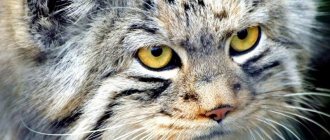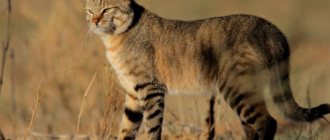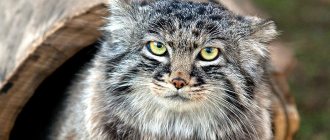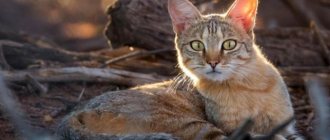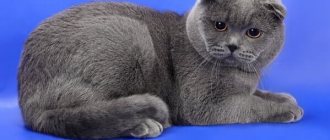The wild cat Manul is a small predator from the cat family that has rapidly captured the minds of millions of people on the planet. Luxurious thick fur and an intelligent look have turned a simple cat into a real Internet star.
Unfortunately, the fur coat attracts not only fans, but also poachers. Therefore, the wild cat is an animal from the Red Book. The population of this type of predator is under strict control and vigilant surveillance.
Description of Pallas's cat
Manul (lat. Felis manul synonym Otocolobus manul) is a charming representative of the cat family, known as the slowest and clumsiest of wild cats.
The owner of a fluffy fur coat and a calm expression on his face quickly became a favorite of Internet users around the world. Interest in this species has appeared quite recently; the breed is poorly studied at the moment.
The fluffy animal has many names: in certain circles the Pallas cat is known as Pallas's cat. It received such an unusual name in honor of its discoverer. In the 18th century, the German naturalist Peter Pallas met a wild cat on the shores of the Caspian Sea, and then included it in zoological reference books and encyclopedias.
Biologists call the Pallas's cat differently: the synonymous name otocolobus comes from the Greek “otos” - ear and “colobos” - ugly, that is, the literal translation sounds like “ugly ear”, although in fact the ears of the Pallas's cat are not that, they are very neat and cute .
This type of cat prefers solitude, and having once chosen a habitat, it remains faithful to it until the last days of its life. If by chance another cat sneaks into his territory, he will be immediately expelled in disgrace.
What does it look like
A wild cat is not very different in size from a domestic cat, but it looks very impressive. The length of its body varies between 52-65 cm, the tail - within 30 cm, and the weight of the Pallas's cat, depending on the gender, can be either 2 kg or 5 kg.
The calling card of this cat is his fluffiness. The size of the predator looks impressive precisely because of its fur: the description of the animal in the reference book says that per square centimeter of the surface of its body there are up to 9000 hairs, which can reach a length of 70 cm each! One can only guess how much such a luxurious “fur coat” weighs.
The head, small compared to the body, has a flattened shape, in tandem with fluffy fur; this factor makes scientists consider Pallas' cats and Persian cats to be distant relatives. The head of a wild cat ends with small, widely set ears.
Yellow eyes also attract attention, the pupils of which do not take on a slit-like shape, like those of other felines, but remain round even in bright sunlight.
The Pallas's coat is a recognized record holder for the length and number of hairs. During the year, its fur has a light gray tint. The color changes slightly in winter and is an interesting combination of light gray and fawn. The hairs are not uniform in color, have white tips, resulting in a feeling of a snowy coating.
The tail does not differ in color from the main color, but at the end it has 6-7 transverse stripes of a darker shade. The underparts are brown with white overlay. The predatory facial expression of the charming wild cat is ensured by stripes on the sides of its muzzle: 2 black stripes stretch across its cheeks.
These cats are inhabitants of the arid steppe, evolution has taken care of the animal’s eyes: a high blinking speed allows them to remain hydrated and protected from sand.
Features of reproduction
The duration of the estrus period is 42 hours, pregnancy lasts 2-2.5 months. The period of appearance of a new litter is April, May. Until the kittens are 4 months old, they are constantly near their mother, as they are completely incapable of independence.
Kittens that are already 4 months old begin to take an active part in hunting. Eye opening occurs between 10 and 12 days from birth. The kitten's weight is 100-300 g, length - 12 cm, no more. Kittens grow quite quickly and intensively, and they also gain weight - 2 months after birth, the kitten already weighs 0.5 kg. Sexual maturity occurs at 10 months.
Lifestyle and nutrition of Pallas's cat
The steppe manul cat goes hunting at dusk: at night or early in the morning he ambushes, waiting for his prey near holes or stones. This predator is clumsy and slow; it will not be able to pursue its prey for long, so it chooses a different tactic. His strengths are his perseverance and fur, which blends perfectly with the colors of the surrounding area.
The Pallas' cat's daily menu consists of gape birds in the summer; the rest of the time he is not averse to dining on pikas and rodents, occasionally diluting his diet with clever gophers and hares. In bad times, the wild cat eats insects.
Habitat
A comfortable habitat for Pallas’ cats is the key to a long and well-fed life. The wild cat lives in nature in Central and Central Asia, and is found in Europe and even in Russia.
Often a name is assigned to a cat based on its place of residence. Thus, in Altai, in Tuva and in the Krasnoyarsk Territory, the Transbaikal Pallas's cat lives (all these areas are located just beyond Lake Baikal, they are called Transbaikalia).
Its Trans-Caspian brother is most common in more eastern latitudes: it is comfortably located in Uzbekistan, Pakistan, Iran and Kyrgyzstan. Tibetan Pallas' cats live in the steppes and mountain crevices of Nepal and, of course, Tibet.
The life and diet of a wild cat take place in steppe and semi-desert areas, covered with low grass and thickets of low bushes. The predator can handle small obstacles, but you won’t find it near steep cliffs.
Types of Pallas's cats
Within the species, there are three breeds for Pallas cats. They are not very different from each other, there is only a minor difference in color.
- The common or Siberian Pallas cat has a standard light gray color and lives in Siberia, Mongolia and China. It was this subspecies that was discovered by the naturalist Pallas;
- Central Asian Pallas's cat - this species is distinguished by its reddish-brown color and clearly visible reddish-brown stripes on its body. This subspecies has been known since 1842. The main habitats are Uzbekistan, Iran, Turkmenistan and Afghanistan.
- Tibetan Pallas's cat - its fur is darker than that of the usual representative of the breed, and in winter it acquires a precious silver tint. The forest cat lives in Tibet, Nepal, India and Pakistan. He became known to the world at the same time as his Central Asian brother.
Breed subtypes
Manul is the main breed that has its own standards of appearance. The breed has several subspecies, each of which differs in its color and habitat.
Siberian manul
The habitat of Siberian individuals is Mongolia, China, Tyva and Transbaikalia. The color of the animal is standard (according to the breed), gray shades predominate in the coat, with white inclusions at the tips.
Tibetan variety
These individuals are common in Tibet, Nepal and Kashmir. The peculiarity of the color is that the coat is darker with black spots on the body, black stripes run along the tail and head, as well as the back. In winter, the animal's fur is covered with silver spots.
Central Asian Pallas's cat
The habitat of this subspecies is Pakistan, Iran, Kazakhstan, Afghanistan, Kyrgyzstan. Representatives of this subspecies have a distinctive coat color - with a pronounced reddish tint, in which ocher color predominates. Dark lines with precise boundaries run along the body and tail; the color of the lines is red.
Character and behavior
Creating the image of a wild cat, the imagination draws pictures of an unbridled predator, ready to fight and chase. The character of the Pallas's cat is very different from the usual associations.
This is an extremely cautious animal, not ready to risk its health for the sake of the most coveted prey. In case of danger, he will not rush to run headlong - this is not his strong point.
The Pallas's cat is a master of camouflage; he can sit in a shelter, without moving or making a single sound, for quite a long time.
He feels good in the early morning and early hours of the night. The rest of the time, the cat is lethargic and inactive, giving preference to sleep and rest, he saves energy for really important matters - obtaining food and preserving his life.
When answering the question whether it is possible to tame a Pallas's cat, one cannot give a definite answer: a wild cat at home is an unusually rare and little-studied phenomenon.
A few owners of pets of this breed say that the animal has a cool disposition, is non-communicative and aggressive. He quickly forgets the person who fed him and shows the nature of a predator from the age of 3-4 months.
The manul does not like company and games, and tries to avoid both humans and other pets. In response to stroking, he may scratch or bite strongly.
Perhaps the popularization of the breed will do its job, and after just a few generations of animals born in captivity, Pallas' cat fans will be able to safely acquire furry friends.
Reproduction and care of offspring
Once a year, in February-March, the mating season begins. It differs from a similar stage in the life of domestic cats in its relative calm.
After 60 days from mating, 2 to 5 Pallas cat kittens appear in a hidden den. Babies are born blind, with short and thick fur. Even at this tiny age, babies behave carefully and do not give away the location of the den with their behavior. Only their mother takes them outside.
As they grow up and get used to their surroundings, the kittens play and try hunting techniques on each other.
The first attempt at real hunting occurs at the age of three months. Seals acquire independence before the annual mating season at the age of 10 months.
Under natural conditions, Pallas cats live 10-12 years.
Manul at home
A wild manul cat can become a real hurricane: it is unpredictable and requires enormous patience on the part of the person who decides to purchase it. It does not get along very well with people: the animal does not feel gratitude for food and affection, and is practically not amenable to education.
The reality of owning a wild cat will be damaged furniture, torn curtains and wallpaper, and sleepless nights. The wild cat stays awake during the first half of the night and early in the morning, sleeping while the owner is at work.
Another problem will be the signature feature of the breed - its fluffiness. The domestic manul requires careful care, which must certainly include constant brushing, since the hair on these cats flies in clumps, and they shed almost all year round.
Kittens of this breed, raised in captivity, have poor immunity and often get sick. It is almost impossible to get them back on their feet, since, unlike an ordinary cat, there are currently no treatment methods.
It will not be easy to purchase a Pallas's cat: it is rare to find an official breeder, and catching animals is prohibited by Russian law.
The price for a healthy cat starts from 3 thousand dollars.
Before you decide to buy, you should carefully weigh the pros and cons and understand whether you can provide him with a comfortable life. A manul at home is a big responsibility.
Status and protection of the Pallas' cat
Everywhere, not excluding even nature reserves and protected areas, the Pallas's cat is rare or extremely rare. The fluffy wild cat Pallas often becomes a coveted trophy of poachers, who catch them for their luxurious fur and resale to exotic lovers.
A lot of individuals die every year from the paws of large dogs released from a leash; other animals fall into the placed nets and traps of would-be hunters.
But it is not only humans who are to blame for the fact that there are almost no Pallas' cats left. Sometimes animals cannot get food due to a decrease in the number of gophers and hares that they usually feed on. The wild cat also has its enemies in the animal world: often animals, especially young ones, are destroyed by wolves and eagle owls.
The Pallas's cat is listed in the Red Book of the Russian Federation and on the IUCN Red List with the status of "nearly endangered", and their numbers continue to decline. For more than 15 years, the status of the wild cat has been defined as rare even in its native habitat.
They are trying to increase the population of this species through captive breeding: the Pallas's cat is a well-known public favorite. But zoos often face high mortality rates in kittens under 3 months of age due to low immunity, although adult animals in captivity suffer relatively little, and their life expectancy almost doubles.
Distribution and species
Pallas' cats live in Central and Central Asia. The distribution area is quite wide: from Southern Transcaucasia, Mongolia to South-Western China. Over the past 15 years, the number of these animals has sharply decreased, so now Pallas’s cat is practically not found in the steppes.
The color and size of Pallas' cat depends on the habitat.
A total of three types are classified:
- The typical fur color is light gray interspersed with ash; black stripes stand out sharply on the body. Lives mainly in Mongolia and Western China.
- Darker color with a predominance of black and brown. The stripes are dark and clearly highlighted. Distributed in Iran, Kyrgyzstan, Kazakhstan, Uzbekistan, Turkmenistan, Tajikistan, Pakistan and Afghanistan.
- Pallas' cats, which live in Nepal, Tibet and Kashmir, boast some of the most interesting colors. Gray fur turns silver in winter.
The Pallas's cat boasts a surprisingly thick coat. Its density is about 9000 hairs per cm²! For comparison, the wool of ordinary sheep has a density of 800 to 3000 per cm², and merino wool has a density of 4500 to 8800.
In addition to thicker axial fibers, Pallas's wool has a fluffy undercoat, which ensures warmth even in severe frosts. This feature, unfortunately, has made the Pallas's cat a valuable fur-bearing animal and a desirable trophy for any poacher. Products made from Pallas fur are considered one of the most expensive, which negatively affects the wild cat population.
It’s worth remembering: keeping a Pallas’s cat at home is a serious test for owners. In addition to the “complex” nature, wool also poses a problem. It can cause allergies, and during the molting period it will literally cover all surfaces in the house.


